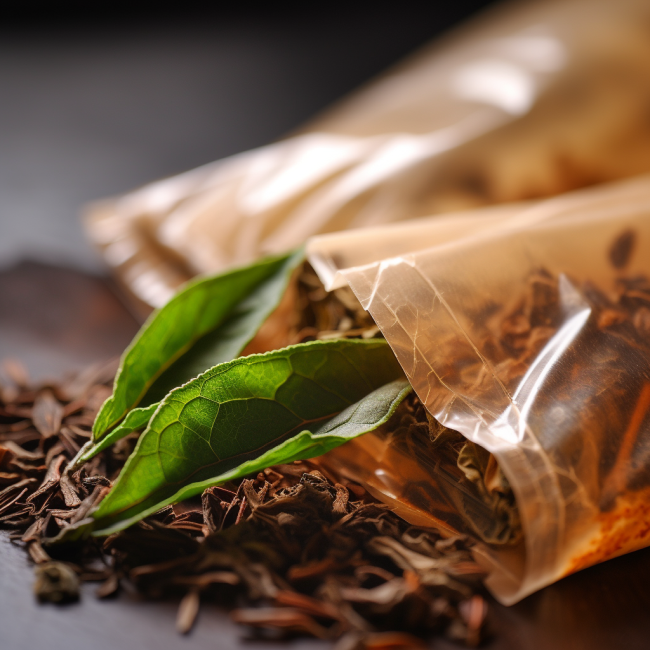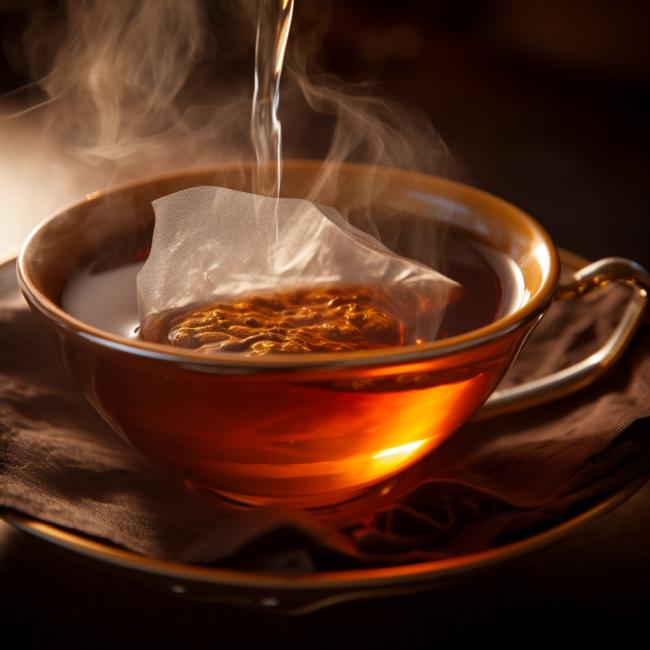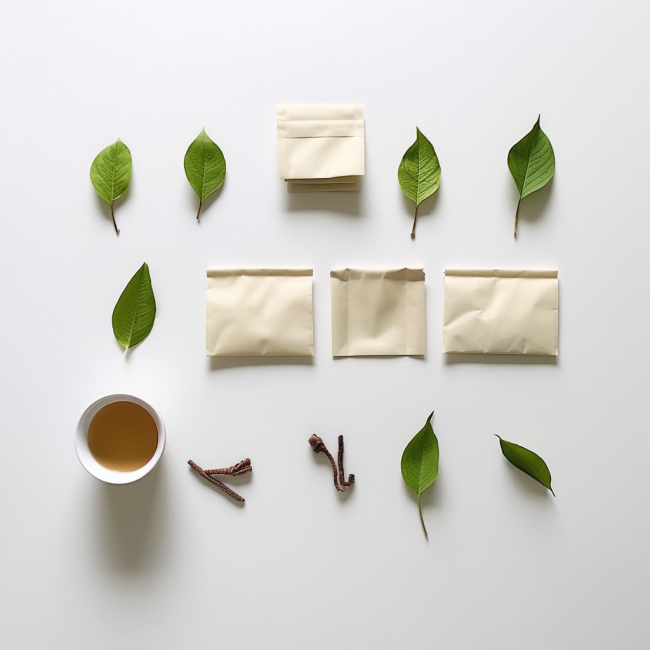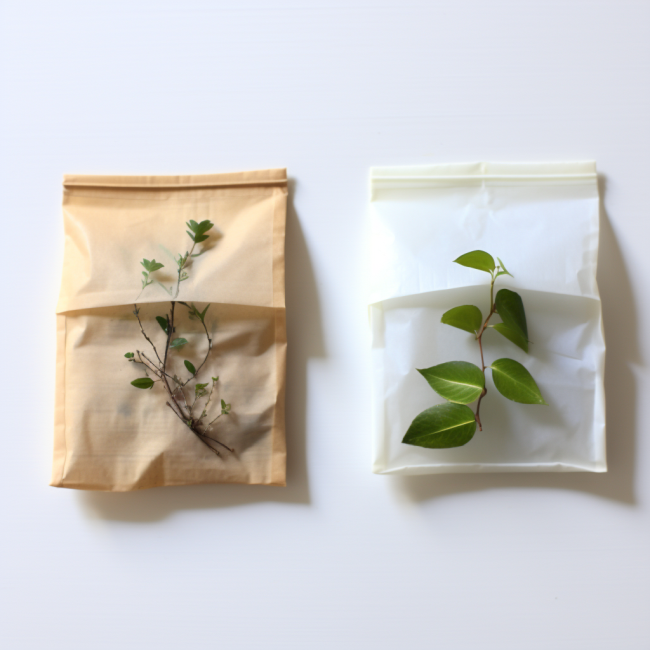
Ever wonder what the difference is between tea bags and loose tea? Then you're in luck because this article is all for you. We dive into the fascinating world of tea, comparing both tea bags and loose tea, and looking at taste, cost, health benefits, and more. This journey is definitely worthwhile, so grab a cup of tea and join me. Welcome to the battle between loose tea and tea bags.

Differences between loose tea and tea bags
There are several important differences between loose tea and tea bags that are worth knowing. Let's look at these differences in detail.
The first difference has to do with the quality of the tea. Loose leaf tea is often considered the crème de la crème of ways to brew tea. Because loose leaves are larger and undamaged, they better retain their oils and flavors, resulting in a fuller and richer taste. Tea bags, on the other hand, usually contain smaller pieces of tea leaves or even tea dust, also known as "fannings" or "dust. Although they infuse faster, they can lose their flavors faster and often provide a less satisfying taste than that of loose tea.
In addition, the method of preparation is another notable difference. Preparing loose tea usually requires a tea egg, a French press, or a teapot with a built-in infuser to separate the tea leaves from the water after brewing. Tea bags, on the other hand, are more convenient and quick to use - just toss the bag into hot water, wait for it to infuse sufficiently, and you're ready to go.
- Variety is another important difference. The world of loose tea can be compared to that of fine wine. There are thousands of different types of loose tea, each with its unique flavor, aroma, and character. This means that loose-leaf tea lovers can enjoy exploring a broad spectrum of flavors and experiences. Tea bags, on the other hand, usually offer less variety.
- Finally, the environmental friendliness of the packaging may also be a consideration. Many tea bag brands still use non-biodegradable materials in their bags and packaging, while loose tea usually comes in recyclable tins or paper bags.
So, as you can see, there are quite a few significant differences between loose tea and tea bags. It's up to you to decide which one better suits your needs and taste preferences.

How do tea bags and loose tea affect taste?
The taste of a cup of tea is influenced by many factors. Two of the biggest players in this puzzle are the type of tea, whether it is loose tea or tea in a bag, and the method of preparation. Let's uncover these factors and see how both tea bags and loose tea can affect the overall taste of your cup of tea.
One of the most important factors determining the taste of tea is the quality and integrity of the tea leaves. Thus, loose tea leaves, which are usually larger and whole, are grown, picked, and processed in such a way that they retain the full range of natural aromas and flavors of the tea plant. As a result, loose tea is usually richer and more complex in flavor than tea from bags.
Tea bags, on the other hand, usually contain "dust" or "fannings" - the smallest pieces of tea leaves. Although these infuse quickly and have a strong flavor, they tend to lose their subtle notes and aromas, making them taste less complex and sometimes more bitter than loose tea.
The next element that affects flavor is the method of preparation. Loose tea needs enough space to swell and move freely in the water to release all the rich flavors and aromas. Tea bags sometimes restrict the movement of the leaves, which can limit infusion and thus flavor. Therefore, the use of a spacious tea infuser or teapot with a wide filter is recommended for loose-leaf tea.
Factors to consider are also water temperature and infusion time. Each type of tea, whether green, black, oolong, or white, has its optimal water temperature and infusion time to provide the best flavor. Loose tea may take some practice to get this right, but once you get the hang of it, you can easily adjust the strength and flavor of your tea. Tea bags offer less flexibility in this regard, but they are more convenient and easier to prepare.
In short, both loose tea and tea bags can offer delicious flavors and aromas, but they do so in different ways and with different results. It is all a matter of your personal preference and how much time and effort you are willing to invest in your tea.

Ecological impact of tea bags and loose tea
In this day and age, it is important to think about our consumption habits and their impact on the environment. Even with our tea habits, we can take steps to live a more sustainable life. Today, let's compare the carbon footprint of tea bags and loose tea.
First, let's understand what a tea bag actually is. Tea bags are often made from a mix of paper, plastic, and sometimes real silk. This means that even though they are mostly made of paper, they are often not fully compostable because of the plastic fibers. In addition, many tea bags are individually wrapped in plastic or foil to keep them fresh, which generates additional waste.
In contrast, loose tea is typically sold in bulk and packaged in recyclable tins or biodegradable paper bags, significantly reducing waste. However, using loose tea does require a teapot or tea infuser, both of which also have an environmental cost.
Another aspect to consider is the transportation of the tea. Because loose tea is usually of higher quality, it is often transported longer distances, sometimes from small farms on the other side of the world. This can result in higher carbon emissions compared to tea bags, which are often produced and packaged on a larger scale.
- Finally, there is the issue of fair trade and ethically produced tea. Many loose-leaf tea brands work directly with tea farmers and ensure fair wages and working conditions, while this is often less the case with tea bags.
In general, when it comes to environmental impact, loose tea can be a better option compared to tea bags, especially if you choose tea produced and processed locally or within a short distance. But it is important to always be well informed and choose brands that prioritize sustainability and ethical production practices.
Advantages of switching to loose-leaf tea
Switching from tea bags to loose tea can seem like a big step at first. But the benefits of this shift can be surprising and worthwhile. Let's take a look at some of these benefits.
One of the greatest benefits of switching to loose tea is its enhanced flavor and aroma. Loose tea leaves have room to expand and develop their full flavor and aroma when brewed, resulting in a curly, rich, and often complex brew. Tea bags, on the other hand, often contain lower-quality teas and cannot offer the same depth of flavor due to their limited space.
Another advantage is the ability to adjust the strength of your tea. With loose tea, you can easily adjust the amount of tea you add to your teapot or infuser to get a stronger or weaker brew. This is often not possible with tea bags because the amount of tea in each bag is predetermined.
Switching to loose tea can also be a more environmentally friendly choice. Loose tea leaves are usually sold in bulk and are usually stored in recyclable or reusable containers, resulting in less packaging waste. Tea bags, on the other hand, are often individually packaged and contain plastic fibers, making them less compostable and thus less environmentally responsible.
- Finally, the process of brewing loose tea can be a calming and meditative experience. The quiet rhythm of measuring and brewing loose tea can offer a chance to slow down and take a moment for yourself in our busy, modern lives. And isn't that what tea is really all about?
In summary, switching to loose-leaf tea offers a range of benefits, from improved taste to reduced environmental impact. And it can even offer a moment of peace in an otherwise busy day. So why not give it a try?
Cost analysis: loose tea versus tea bags
When it comes to the cost of tea, there can be big differences between loose tea and tea bags. Here's a deeper look at the cost of each.
First, let's take a look at the cost of tea bags. A box of tea bags seems cheap at first glance. They are often sold in large quantities at an affordable price, making them a popular choice for the everyday tea drinker.
However, despite the initial affordability, the cost of tea bags ends up being higher when you consider them in the long run. This is because each tea bag contains a specific amount of tea intended for one use.
In addition, if you are a fan of flavored teas, the cost can shoot up even further. This is because flavored tea bags often cost more than the standard black or green varieties.
In contrast, the cost of loose tea may seem higher at first glance. In fact, when you buy loose tea, you usually pay for higher-quality tea leaves.
However, you should also consider the fact that loose tea can withstand multiple infusions. This means you can use the same amount of tea more than once - some teas are known to have good second and even third infusions.
In addition, because you can measure the amount of tea you use for each brew yourself, you have more control over how much you spend per cup. As a result, loose tea can actually be more economical than bagged tea in the long run.
In the final analysis, while tea bags may have an attractive low upfront cost, loose tea may be the better deal in the long run, especially if you are a regular tea drinker. But as always, the choice is yours!

Health benefits of tea bags versus loose tea
Tea is known for its many health benefits. But are there any differences between the health benefits of loose tea and tea in bags? Let's take a look.
It is important to start by saying that both loose tea and tea bags contain antioxidants. Antioxidants are important to our health because they help neutralize free radicals in our bodies, which can lead to less inflammation and lower the risk of chronic diseases such as heart disease and certain cancers.
Loose tea, however, may have a higher antioxidant content simply because the leaves are of higher quality and have retained more of their nutrients. But note, As mentioned earlier, antioxidant levels can vary greatly depending on the type of tea, growing practices, processing, and brewing process. Therefore, it is not correct to say that one tea a day could make a higher health contribution than another.
With respect to preparation, the fact that the loose tea leaves are fully immersed and in direct contact with the water may make it easier for the antioxidants and other healthy compounds to infuse into the brew. However, knowledge about this claim is still under investigation.
In general, regardless of whether you choose loose tea or tea bags, drinking tea can provide a wide range of health benefits. As always, it is important to act responsibly and include a variety of foods and beverages in your diet to ensure that you get a wide range of nutrients.
How to prepare loose tea and tea from tea bags?
Preparing tea is an art in itself. Whether you choose loose tea or tea bags, there are a number of tips and steps you can follow to ensure you get the most out of your tea.
First, let's look at preparing loose tea in advance. Start by measuring the right amount of tea. A good basic rule is to use about one to two teaspoons of loose tea per 240 ml of water, depending on your preferred strength. Then, depending on the type of tea, you'll want to heat the water to a certain temperature. A handy guide is to aim for 80ºC for green tea, 90ºC for white and oolong tea, and 100ºC for black and Pu erh tea. Once at the right temperature, pour water over the tea and allow it to steep. The steeping time also varies by type of tea: 2-3 minutes for green tea, 4-5 minutes for white and oolong tea, and 5-6 minutes for black and Pu erh tea. After steeping, strain the tea leaves from the water and your tea is ready to drink.
For preparing tea from tea bags, the procedure is similar but simpler. Simply place the tea bag in your cup or teapot, pour the hot water on top, and steep it according to the instructions on the package. It is important to note that the infusion time and water temperature indicated on the package are meant as guidelines. You can adjust them according to your own taste preferences.
Regardless of your choice, brewing your own cup of tea can be a relaxing and rewarding experience. Whether in the morning to start the day, in the afternoon to refuel, or in the evening to relax, there is nothing more satisfying than a freshly brewed cup of tea.
Loose tea and tea bags: which is the better choice?
The answer to this question really depends on your personal taste, lifestyle, and what you want to get out of your tea moments.
If you prioritize convenience and speed, tea bags may be the right choice for you. They are easy to use, quick to brew, and leave little mess, making them a good option for people with busy schedules or on the go.
In contrast, if you love the process of brewing tea and enjoy the opportunity to experiment with different flavors and strengths, loose-leaf tea may be the perfect choice for you. It offers a wider variety of flavors and varieties and gives you room for experimentation and personalization.
Loose tea is generally considered the superior choice for taste and quality. If you are a true tea lover and don't mind spending a little extra time and effort on your brew, you may find great pleasure in making and drinking loose tea.
But in the end, it's all about personal preference. You can also enjoy both loose tea and bagged tea for different occasions. Perhaps you enjoy making a quick bagged tea in the morning when you are in a hurry and relaxing in the evening with a pot of carefully brewed loose tea.
The important thing is to enjoy your tea in a form and method that suits you best.
How to store: Loose tea versus tea bags
A good cup of tea begins not only with the quality of the tea leaves but also with how you store them. Proper tea storage can help preserve the freshness, flavor, and aroma of your tea leaves. Let's take a look at how best to store both loose tea and tea bags.
Loose tea is particularly sensitive to light, heat, moisture, and strong odors, as these factors can affect the quality of the tea. Therefore, it is important to store your loose tea in an airtight container. This keeps air, moisture, and odors at bay and helps maintain the freshness of your tea. Also avoid storing your tea near spices, coffee, or anything else with a strong odor, as tea can absorb odors.
For optimal freshness and flavor, it is a good idea to store your tea in a cool, dry, and dark place, such as a kitchen cabinet or pantry. It is also recommended that you use your tea within a year of purchase, although this may vary depending on the type and quality of the tea.
For tea bags, many of the same rules apply. You want to keep them in a cool, dry, dark place and keep them away from strong odors. However, because many tea bags already come in individual containers, they have an extra layer of protection against moisture and odors.
Storing your tea properly, whether loose or bagged, is a simple step you can take to preserve the quality and flavor of your tea. So next time you buy a new batch of tea, remember to put these tips into practice!
Whether you're a fan of tea bags or a fan of loose tea, it's clear that both forms have their own unique benefits and characteristics. Choosing the right form depends entirely on your taste preferences, lifestyle, and what you want to get out of your tea moments. Hopefully, this article has helped you gain a better understanding of the differences between tea bags and loose tea.
Hugs,
Admar
.png)

